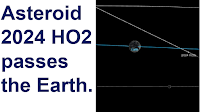Asteroid 2024 HP passed by the Earth at a distance of about 592 000 km (15.4 times the average distance between the Earth and the Moon, or 3.96% of the distance between the Earth and the Sun), with a relative velocity of about 7.67 km per second, slightly before 5.00 pm GMT on Thursday 23 May 2024. There was no danger of the asteroid hitting us, though were it to do so it would have presented a significant threat. 2024 HP has an estimated equivalent diameter of 160-350 m (i.e. it is estimated that a spherical object with the same volume would be 160-350 m in diameter), and an object of this size would be expected to penetrate the Earth's atmosphere and impact the Earth's surface, causing an explosion with an equivalent energy release to between 1.5 and 12.8 megatons of TNT. An impact at the lower end of this range would be expected to flatten forests and man-made structures over a significant distance, while one at the upper end of the range could cause a crater 2.87 km in diameter and global climatic effects which would persist for decades if not centuries.
2024 HP was discovered on 17 April 2024 (36 days before its closest approach to the Earth) by the University of Arizona's Mt. Lemmon Survey at the Steward Observatory on Mount Lemmon in the Catalina Mountains north of Tucson. The designation 2024 HP implies that the asteroid was the fifteenth object (asteroid P - in numbering asteroids the letters A-Z, excluding I, are assigned numbers from 1 to 25, with a number added to the end each time the alphabet is ended, so that A = 1, A1 = 26, A2 = 51, etc., which means that P = 15) discovered in the second half of April 2024 (period 2024 H - the year being split into 24 half-months represented by the letters A-Y, with I being excluded).
2024 HP is calculated to have a 983 day (2.69 year) orbital period, with an elliptical orbit tilted at an angle of 6.53° to the plain of the Solar System which takes in to 1.01 AU from the Sun (101% of the average distance at which the Earth orbits the Sun) and out to 2.85 AU (2.85 times the distance at which the Earth orbits the Sun, almost twice the distance at which the planet Mars orbits).
2024 HP is therefore classed as an Apollo Group Asteroid, which is an asteroid that is on average further from the Sun than the Earth, but which does get closer (1.01 AU from the Sun would appear to be further from the Sun than the Earth, which is, on average 1.00 AU from the Sun, but at aphelion, which happens in July each year, the Earth reaches almost 1.02 AU from the Sun). As an asteroid possibly larger than 150 m in diameter that occasionally comes within 0.05 AU of the Earth, 2024 HP is also classified as a Potentially Hazardous Asteroid.
2024 HP is calculated to have fairly regular close encounters with the Earth, with the last thought to have happened in April 2016 and the next predicted for August 2032.
See also...


.jpg)
b.jpg)







%20(1)%20(1).png)